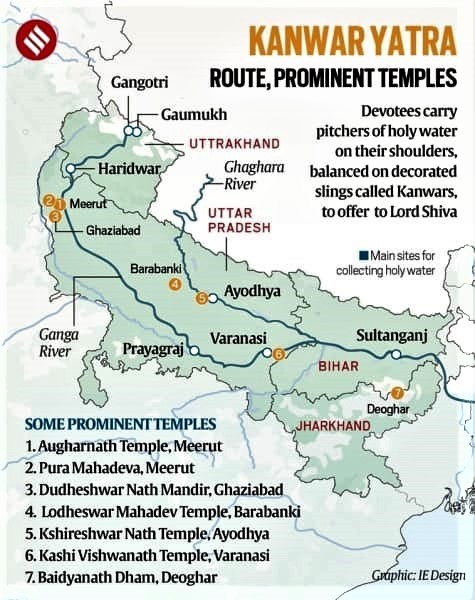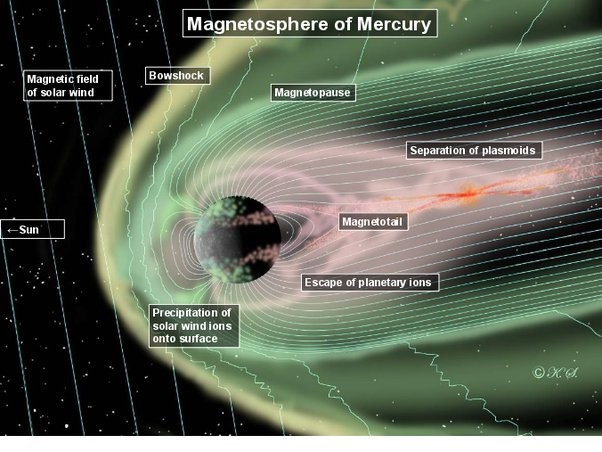Heat Index
India Meteorological Department (IMD) has recently launched the Heat Index on experimental basis.
- The heat index, also known as the apparent temperature, is what the temperature feels like to the human body when relative humidity is combined with the air temperature.
- Launched by - India Meteorological Department (IMD)
- Aim - To provide general guidance for the regions within India where, the apparent temperature/feel like temperature are on the higher side causing discomfort for the people.
- Ministry – Ministry of Earth Sciences
- Colour codes used for experimental heat index, according to IMD are as follows:
|
Colours
|
Experimental Heat Index
|

|
|
Green
|
Less than 35 deg C
|
|
Yellow
|
In the range 36-45 deg C
|
|
Orange
|
In the range 46-55 deg C
|
|
Red
|
Greater than 55 deg C
|
- A severe heatwave is declared when the temperature is above 40 degrees Celsius and 6.5 degrees above normal.
- The map is plotted by taking into account the forecast temperatures and humidity values of different places at 2.30pm, when the heat is usually at its peak.
- The higher the humidity, the higher the heat index.
- It is important to factor in humid heat, even more so than dry heat, as there is loss of life even at lower temperatures when humidity is high.
- At present, heat index is derived using the heat index equation similar to what is used by National Weather Service, National Oceanic and Atmospheric Administration (NOAA), USA.
Heat index for Bhubaneshwar and Ahmedabad under Heat Action Plan is done under project mode by National Disaster Management Authority (NDMA) in collaboration with local agencies like Indian Institute of Public Health (IIPH).
National Oceanic and Atmospheric Administration’s Heat Index

References
1. PIB | Shri Kiren Rijiju says IMD has launched Heat Index
2. NOAA | what is the heat index?
3. The New York Times | what is the heat index?
Kanwar Yatra
The kanwar Yatra that attracts million of devotees of shiva in state of Uttarakhand had concluded recently.
- The Kanwar Yatra is a pilgrimage organised in the Hindu calendar month of Shravana (Saavan), usually from July to August.
- During this yatra, millions of devotees of Lord Shiva known as 'Kanwariya' make a journey to Haridwar, Gangotri, and Gaumukh in the state of Uttarakhand.
The pitchers of holy water balanced on decorated slings are known as Kanwars.
- The water is used by the pilgrims to worship Shiva lingas at shrines of importance, including the 12 Jyotirlingas, or at certain specific temples or even in the devotee’s own village or town.

- In the Gangetic plains, the water is taken from pilgrimage sites such as Haridwar, Gaumukh and Gangotri in Uttarakhand, Sultanganj in Bihar, and Prayagraj, Ayodhya or Varanasi from Uttar Pradesh.
- Similarities - Kanwar yatra in North India is celebrated as Kavadi festival in Tamil Nadu in which Lord Muruga is worshipped.
- Mythology - The ritual goes back to the ‘samudra manthan’, narrated in the Bhagavata Purana and in the Vishnu Purana, which explains the origin of ‘amrita’, or the nectar of immortality.
- Another origin story of the Kanwar yatra is linked with Lord Parashuram, a devotee of Shiva.
The term “Bol-Bam” refers to pilgrimages and festivals in the countries of India and Nepal glorifying Lord Shiva who is also known as Bam. References
1. The Indian Express | Kanwar yatra concludes for the year
2. euttaranchal | Kanwar Yatra guidelines 2023
3. Rgyan | Origin of Kanwar Yatra
4. Tour my India | About Kanwar Yatra
NASA's DIMPLE Instrument
NASA selects Artemis instrument – DIMPLE to study Irregular Mare Patch on the Moon.
- DIMPLE – Refers to “Dating an Irregular Mare Patch with a Lunar Explorer” scientific payload.
- Aim - To establish the age and composition of hilly terrain created by volcanic activity on the near side of the Moon.
- Agency – NASA, USA
- Program - It travels to the Moon as a part of Artemis program.
- DIMPLE is accepted through NASA’s Payloads and Research Investigations on the Surface of the Moon (PRISM) program via the Commercial Lunar Payload Services (CLPS) initiative.
- It will investigate the Irregular Mare Patch, (smooth, rounded, slightly mounded areas on the Moon) discovered in 1971 by Apollo 15 orbital images.
- The mission will use a rover, a collection instrument and a spectrometer that can determine the composition of lunar material.
- Significance – Dimple will add to a growing body of knowledge about the Moon, which in turn helps us understand the origins of Earth and other planets in the solar system.
- Additionally, the more we understand about our closest neighbor, the more we can support long-term human exploration at the Moon, and someday, Mars.
Artemis programme is an American-led effort to return humans to the moon by 2025, with the ultimate goal of expanding space exploration to Mars and beyond.
Commercial Lunar Payload Services (CLPS) initiative
- This initiative allows rapid acquisition of lunar delivery services from American companies for payloads that advance capabilities for science, exploration or commercial development of the Moon.
- Under Artemis, commercial deliveries beginning in 2022 will perform science experiments, test technologies and demonstrate capabilities to help NASA explore the Moon and prepare for human missions.
References
1. The Indian Express | NASA selects Artemis instrument to study Moon
2. Universetoday | NASA Artemis DIMPLE Instrument Suite
3. NASA | New NASA Artemis Instruments
4. NASA | commercial-lunar-payload-services
Agariyas of Kutch
A group of saltpan workers requested Gujarat Chief Minister for state intervention over forest department officials issuing instructions barring their entry in the Little Rann of Kutch.
- Agariyas - Agariyas are socially recognized as “Chunvaliya Koli” “Miyana” “Sandhi” community all of them fall into De-notified tribe (NTDNT) category.
- In their language, agar means salt and those who farm it are called Agariyas.
- Salt production - Coastal salt is called as “Sea Salt” locally known as “karkacch salt” where in Little Rann of Kutch Agariyas make crystal salt called “Vadagaru” or “Poda”.
- Current issue - The forest department wants the Agariyas to leave the Little Rann but the Agariyas are pacifists who do not in any way harm the endemic wild asses that number some 5,000.
Gujarat is the largest producer of salt in India and the agariyas produce over 30% of India’s entire salt produce from the Little Rann of Kutch.

Kutch
- Kutch is a district of Gujarat state.
- The Rann is known for its marshy salt flats which become snow white after the shallow water dries up each season before the monsoon rains.
- The district is also known for ecologically important Banni grasslands with their seasonal marshy wetlands which form the outer belt of the Rann of Kutch.
- Kutch is an island, as it is surrounded by the Arabian Sea in the west and the Gulf of Kutch in south and southeast.
- The northern and eastern parts are surrounded by the Great and Little Rann (seasonal wetlands) of Kutch.
- The entire Little Rann was notified as a wildlife sanctuary in 1973 and, since 2006, exists inside a wild ass sanctuary.
Indian Wild Ass
- The Indian Wild Ass is a species of ass that is native to the countries of southern Asia.
- It is one of the 4 remaining subspecies of the Asian Wild Ass, and it can only be found in India.
- Local terms - Ghudkhur, Khur, or Indian onager.
- The Indian Wild Ass, in contrast to its closely related family of donkeys and horses, has not been domesticated.
- Habitat - These species live in a variety of habitats including wetland ecosystems, deserts, arid grasslands and shrub lands.
- They are currently only found in small numbers in India's Rann of Kutch region.
- IUCN Status - Near Threatened.
References
1. Down to Earth | Saltpan workers debarred from entering Little Rann
2. Live Mint | Including the agariyas
3. Joshua Project | The Agariya (Hindu traditions)
4. AHRM India | About Agariya
5. Bootcamp | The Story of the Agariyas of Kutch
X-ray Auroras
During a close Mercury flyby, the BepiColombo spacecraft collected data that showed how electrons raining down on the planet's suface are triggering X-ray auroras.
- Auroras - An aurora is a natural colourful light display that shimmers in the sky.

X-ray Auroras in Mercury
- High energy electrons from the solar wind rain down on Mercury's surface and, because they are not restricted by a thick atmosphere, they hit the surface.
- This process emits an auroral glow in the form of X-rays.
- For the first time, scientists have witnessed how electrons are accelerated in Mercury’s magnetosphere and precipitated onto the planet’s surface.
- MESSENGER Mission- Aurorae at Mercury had previously been observed by the MESSENGER mission, but the exact processes that cause the x-ray aurora had not been well understood.
- Mercury’s magnetosphere is much smaller than Earth’s and has a different structure and dynamics, that is evident that generates aurorae is the same throughout the Solar System.
|
Auroras in Earth
|
Auroras in Mercury
|
|
Auroras on Earth are triggered when a stream of charged particles emitted by the Sun interact with the ionosphere, the electrically charged upper layer of the planet’s atmosphere.
|
Mercury has thin/no atmosphere and auroras on the planet are created when solar wind interact directly with the planet’s surface.
|
- BepiColombo is a joint mision by the European Space Agency (ESA) and the Japanese Aerospace Exploration Agency (JAXA).
- To know more about the Bepi Colombo mission click here.
References
1. The Indian Express | Electron rains on Mercury cause X-ray auroras
2. Science News | A rain of electrons causes Mercury’s X-ray auroras
3. Salon | Spaceprobe captures Mercury's high-powered X-ray auroras



